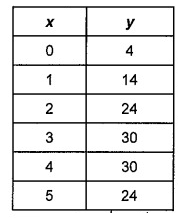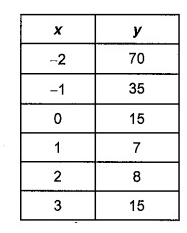USING FINITE DIFFERENCES TO FIND THE DEGREE OF POLYNOMIALS
Finite difference :
The first-order differences of a polynomial function f(x) are found by subtracting function values for equally spaced x-values.
The second-order differences are found by subtracting consecutive first-order differences.
The third-order differences are found by subtracting consecutive second-order differences, and so on.
Use finite differences to determine the degree of the polynomial that best describes the data.
Problem 1 :

Solution:
Since fourth difference are same, it is polynomial of degree 4.
Problem 2 :

Solution:
Since third difference are same, it is cubic polynomial. The degree of the polynomial is 3.
Problem 3 :

Solution:
Since second difference are same, it is a quadratic polynomial. The degree of the polynomial is 2.
Problem 4 :

Solution:
Since third difference are same, it is cubic polynomial. The degree of the polynomial is 3.
Curve Fitting with Polynomial Models
Carla has been making a "wild scape" in her backyard. The table shows the number of birds visiting her feeder at the same hour
on the first day of each month since she began her project. Use a polynomial model to make a reasonable estimate of the number of birds there might be in July.

Problem 5 :
Use finite difference to determine the degree of the polynomial that best fits the data.
a. First differences ______
b. Second differences _____
c. Third differences _____
d. Fourth differences _____
e. Which degree polynomial best describes the data?
Solution:
Since third difference are same, it is cubic polynomial. The degree of the polynomial is 3.
Problem 6 :
Consider this data:

a. Calculate finite differences to find the degree of the polynomial function that models these data.
b. What is the minimum number of data points required to determine the degree of this polynomial function? Why?
c. Find the polynomial function that models these data and use it to find s when n is 12.
Solution:
a.
Since second difference are same, it is a quadratic polynomial. The degree of the polynomial is 2.
b.
y = ax2 + bx + c
Put x = 1 and y = 1
1 = a(1)2 + b(1) + c
1 = a + b + c ---> (1)
Put x = 2 and y = 3
3 = a(2)2 + b(2) + c
3 = 4a + 2b + c ---> (2)
Put x = 3 and y = 6
6 = a(3)2 + b(3) + c
6 = 9a + 3b + c ---> (3)
Add (1) & (2),
-3a - b = -2 ---> (4)
Add (1) & (4),
-2a + c = 1 ---> (5)
(2) × 3 ==> 12a + 6b + 3c = 9
(3) × 2 ==> 18a + 6b + 2c = 12
_______________
-6a + c = -3 ---> (6)
Add (5) & (6),
4a = 4
a = 1
By applying a = 1 in (5)
-2(1) + c = 1
c = 3
By applying a = 1 and c = 3 in (1)
1 + b + 3 = 1
4 + b = 1
b = -3
c. The quadratic polynomial,
s = 1n2 - 3n + 3
When n = 12, s = ?
s = 1(12)2 - 3(12) + 3
s = 144 - 36 + 3
s = 111
Recent Articles
-
Finding Range of Values Inequality Problems
May 21, 24 08:51 PM
Finding Range of Values Inequality Problems -
Solving Two Step Inequality Word Problems
May 21, 24 08:51 AM
Solving Two Step Inequality Word Problems -
Exponential Function Context and Data Modeling
May 20, 24 10:45 PM
Exponential Function Context and Data Modeling